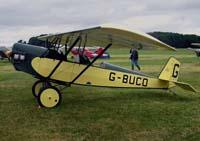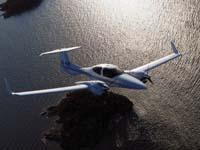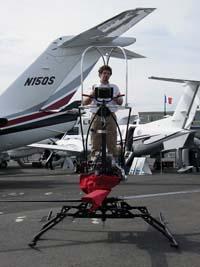Light weight light weight

In addition, there is everything left out of heavy aeronautics: light aeronautics. Aratz Arrangi and Ugaitz Iturbe wanted to act in this regard. They have seen the way forward in the light aircraft and have started working in their company Aeris Naviter with their own product. We have been with them to know the world of light aeronautics.
First, they explain how the planes are classified. European legislation JAR (Joint Aviation Regulation) classifies aircraft by weight. More specifically, depending on the maximum take-off weight (MTOW: maximum take off weigth), that is, taking into account fuel, passengers and everything.
The lightest of this classification are UL (Ultralight) or ultralight, with less than 450 kg. With this maximum weight can accommodate up to two or three people. The second section is the VLA (Very Light Aircraft) or lighter aircraft, which includes aircraft over 450 kg without jet engine. As for jet engines, up to 4,540 kg are VLJ (Very Light Jet) or very light jet. And all superiors are included in the category of Aircraft or aircraft. The UAV drones (Unmanned Aerial Vehicle) are also excluded from JAR legislation. In Europe they are not regulated, but in the US they are.
Heavy aircraft includes the aircraft section, and all of them are light aircraft. "When people talk about aviation, they generally talk about aircraft," says Arrangi, "depending on the volume of the market, aviation is heavy and light, but the light is not known..."

Lightweight
Planes that have had one of the most spectacular evolutions can be ultra-fast. And it is that until a few years ago amateur aviation has been the most ultra-fast. He manufactured them in his own garage, using aluminum tubes, fabrics, wood, etc. However, in recent years there has been considerable progress in materials, motorization, navigation systems and new conceptual designs. And today, some companies have begun to market ultra-light, with the same processes and professionalism as the great aviation.
The composite materials or composites occupy the place occupied by the first metals, fabrics and wood. At present, most commercial aircraft are made of composite material. And in the ultra-light, these materials have also gained great importance. The composites are much lighter and in the case of planes it is always interesting to reduce the weight. Thanks to the new materials it has been achieved that those who were formerly VLA, as well as some heavier ones, become ultralight.
On the other hand, the TDI engines developed in the automotive sector have begun to be used in these aircraft. "This gives great reliability and significantly reduces the cost of operation," explains Iturbe. These engines, in addition, are lighter (aluminum) and by their electronic control they offer a high security.

Before good but now better
VLA or very light aircraft, having more weight, can catch more people, and are usually four or six seats. Although evolution has also been important, there has not been the same leap as in the ultra-light. In fact, the VLA were already included in the professionalism, that is, the amateurs did not. However, they had much to improve.
Previously they were made of metal and currently composites are used. This reduces the weight and, therefore, the fuel consumption. On the other hand, the engines used previously consumed very much both fuel and oil and had little reliability. Now TDI engines are also used. "You can use the same engine as a Mercedes on a light plane," says Arrangi.

There has also been considerable progress in navigation systems. Currently, Fly-by-wire electronic flight systems are used, i.e., computer-managed flight systems. This system was used for the first time in American fighters in the 1970s. Later, Airbus was the first in civil aviation, about twenty years ago. And in the VLAS they have begun to use in the last five years. With this system, the pilot does not act mechanically on the actuators, but uses a computer that acts on them analyzing and interpreting all the parameters of the flight. In this way, optimal flights are achieved.
The yields, speeds and altitudes obtained with advanced designs, composite materials and new motorizations have nothing to do with what was obtained in the designs of 40 years ago. And for the riders there is also a big difference, both in comfort and in safety, says Iturbek-, things that are now much more cared for."
Airetaxis Airetaxis
The very light VLJ or Jet series is very new. About five years ago, the construction of this type of aircraft began in the United States, with the aim of covering a gap in the market. In fact, they saw that there are people in the business world, especially, who do not use conventional airlines, due to scheduling problems, etc., and that neither private jet or business jet jet, for its high cost. On the contrary, they are replaced by small private planes. Therefore, "they saw that there was a vacuum - says Arregik- and that it could be interesting to make small jet that would fulfill a certain airetax- function."
Still only two or three models are certified, but many more are being developed. In addition to the pilot, these planes known as jet or microjet personnel have capacity for four or six people. And, for their novelty, they are manufactured with materials and final technologies: composites, Fly-by-wire flight systems, etc.

"In addition, in proportion they are quite cheap," says Arrangi, "they can cost more than a million dollars." And they want to make them available to as many people as possible, so, besides being economical, they try to reduce the operating costs to the maximum. High efficiency, low fuel consumption, high reliability and low maintenance rate.
Pilot on land, airplane in the air
So far the classification of planes regulated by the JAR legislation. The drones are left out of it and, although they are not yet regulated in Europe, they are increasingly important.

"The drones have had, above all, a military use," explains Iturbe. Initially, they were used to carry out tests with missiles, as their destination. In other words, a small plane was launched and the objective was to shoot the missiles. Then they began to be used for espionage. This is because, in addition to not putting the pilots in danger, the weight saving of the pilot allows to transport more fuel and therefore fly longer. That is why they are very useful for espionage. And the latter are also used to attack. Americans have just taken out the drone for the MQ-9 attack. It has been called “reper” and can carry 1.5 tons of explosives. They announce that from this fall they will begin to be used in Iraq. Yes, the pilots will drive from Arizona with all comfort and without any danger to them.
These planes have had a spectacular development in the last decade. One of the main features is that they have artificial intelligence and, therefore, they are able to follow a certain path, to reach a certain objective, to take photos and videos, etc. They have very advanced navigation systems, satellite communications and very diverse vision and detection systems: infrared, Doppler radars...
In the civil sphere they are increasingly used for conservation tasks, land measurement, photography and video, etc.
When adding rotatives to fixed blades

The pioneer Juan De la Cierva began this path when in 1919 he created a plane with two types of wings: the autogiro. And they are based on self-rotation, although they are much more advanced, the current environment plans. As in Aeris Naviter they intend to develop one of these characteristics.
With both blades, fixed and rotary, the characteristics of both are used. The fixed fin is not used to fly vertically, but once reached a cruising speed, its air resistance is very low and can be achieved a lower consumption and a higher speed. With rotodynamics, however, it is only possible to carry out vertical takeoff and landing, but due to the large surface occupied by the rotor, its air resistance is high, so it is required a very high consumption and a great power to fly, not being able to reach high speeds.
The gyroplanes can give vertical emissions and landings with the main rotor, as well as helicopters, but once in the air, thanks to another horizontal propeller they get the drive and the upward thrust by the wings.

"The current ambient planes are very optimized," says Arregik, "and although in the beginning all the power is delivered to the main rotor, this rotor is slowed to the maximum and the power is passed to the horizontal propeller." With the reduction of the main rotor speed a drastic reduction of the resistance is achieved, which presents a cubic proportion of the rotor speed. That is, if the rotational speed of the rotor decreases by a third, the air resistance decreases 27 times. This allows a lower consumption and a higher speed.
The final result is a plane with vertical takeoff and landing capacity that can reach the same cruising speed as a fixed wing plane (600 km/h). And taking into account the space that conventional planes need to take off and land, these new planes of environment can offer great advantages in this sense.






